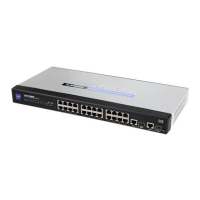Chapter 5
Advanced Configuration
18
24-Port 10/100 + 2-Port 10/100/1000 Gigabit Advanced Smart Switch with 2 Combo SFPs
Log Indicates that the event is a log entry.
SNMP Trap Indicates that the event is a SNMP trap.
Log and Trap Indicates that the event is both a log
entry and a trap.
Community Enters the community to which the event
belongs to.
Owner Enters the name of the person who creates this
event.
Click Save Settings to save the changes.
Statistics > RMON Event Log
The RMON Event Log screen shows the log index number,
the time of an event, and the name of the person who
created this entry.
Statistics > RMON Event Log
Overview
Event Index Displays the event index.
Event Type Displays the event type.
Last time Sent Displays the time that the event was
occurred and sent.
Owner Displays the device or user that defined the
alarm.
Statistics > RMON Alarm
The RMON Alarms screen allows you to record important
events and critical network problems. The RMON Alarm
and Event Control Tables are used together to define
specific criteria that will generate response events.
Alarms can be set to test data over any specified time
interval and monitor changing values, such as a statistical
counter reaching a specific value, or a statistic changing
by a certain amount over a set interval. Alarms can be set
to respond to either rising or falling thresholds.
•
•
•
Statistics > RMON Alarm
Create New Alarm
Index Indicates a specific alarm.
Interval (Sec.) Defines the time interval in seconds over
which data is sampled and compared with the rising or
falling threshold.
Interface The selected interface on the Switch
Counter Selects the counter variables.
Sample Type The method of sampling data, either
Absolute or Delta.
Startup Alarm Indicates how the alarm is activated when
the variable is compared to the thresholds. This can be set
to Rising, Falling, and Rising or Falling.
Rising Threshold An alarm threshold for the sampled
variable. If the current value is greater than or equal to
the threshold, and the last sample value was less than the
threshold, then an alarm will be generated. (After a rising
event has been generated, another such event will not be
generated until the sampled value has fallen below the
Rising Threshold and reaches the Falling Threshold.)
Falling Threshold An alarm threshold for the sampled
variable. If the current value is less than or equal to the
threshold, then an alarm will be generated. (After a falling
event has been generated, another such event will not be
generated until the sampled value has risen above the
Falling Threshold and reaches the Rising Threshold.)
Rising Event The index of the Event that will be used if a
rising alarm is triggered. If there is no corresponding entry
in the Event Control Table, or if this number is zero, then
no event will be generated.
Falling Event The index of the Event that will be used if
a falling alarm is triggered. If there is no corresponding
entry in the Event Control Table, or if this number is zero,
then no event will be generated.
Owner Defines the name of the person who created this
entry.

